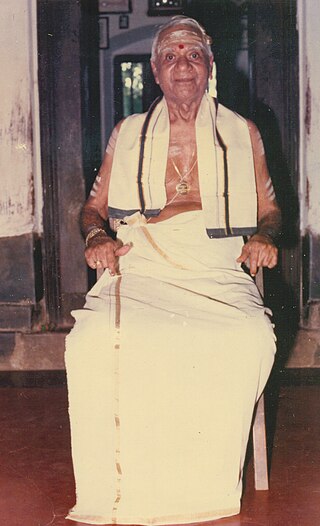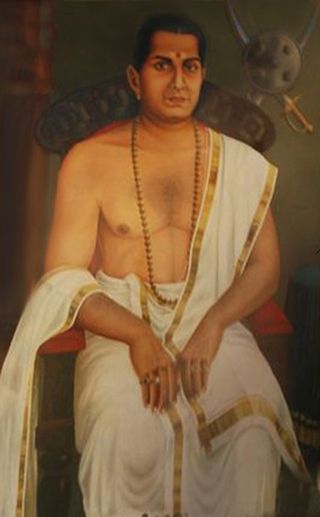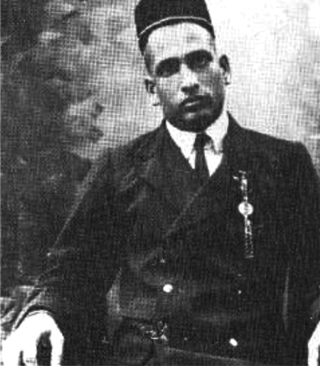Related Research Articles

Kathakali is a traditional form of Indian Classical Dance, and one of the most complex forms of Indian theatre. It is a play of verses. These Verses called Kathakali literature or Attakatha. Mostly played in the courts of Kings and Temple festivals. Hence it known as suvarna art forms. This performance uses the navarasas of Bharathan, the Guru of Indian theatre. Makeup and costumes are very unique and huge. Normally it represent Kerala Art. It is native to the Malayalam-language southwestern region of Kerala and is almost entirely practiced by Malayali people.

Guru Mani Madhava Chakyar (15 February 1899 – 14 January 1990) was a celebrated master performance artist and Sanskrit scholar from Kerala, India, considered to be the greatest Chakyar Koothu and Koodiyattam artist and authority of modern times. He was considered as the authority of Abhinaya and Nātyaśāstra.

Manoj Kuroor is an Indian poet, novelist and lyricist who writes in Malayalam.

Kottakkal Sivaraman was a performing artiste who revolutionised the portrayal of female roles in Kathakali, the classical dance-drama from Kerala in southern India.

Vadakke Manalath Govindan Nair popularly known as Kalamandalam Gopi, is an Indian dancer who is an exponent of the classical dance-drama style known as Kathakali.

Kalamandalam Ramankutty Nair was a performer of Kathakali, who practiced the Kerala art form for more than seven decades.

Pattikkamthodi Ravunni Menon (1880–1948) was a pivotal figure in the history of Kathakali, having played a crucial role in remoulding and refining its grammar in the famed Kalluvazhi tradition of the classical dance-drama from Kerala in south India. He was trained in the art form at a culture-patronising Namboodiri mansion in Vellinezhi near his home.

Mayilpeeli Thookkam also called Arjuna Nritham is a ritual art of Kerala primarily performed by men of the Ezhava community, and is prevalent in the Bhagavathy temples of south Kerala.

Kottayam (Cotiote) was a feudal city-state in Malabar, present-day Kerala, India. Kottayam (Cotiote) is famed for Pazhassi Raja, one of the principal leaders of the Wayanad Insurrection (Kotiote Palassi rebellion or Cotiote War). Pazhassi Raja was a member of the western branch of the Kottayam royal clan. When Hyder Ali of the Kingdom of Mysore occupied Malabar in 1773, the Raja of Kottayam found political asylum in Travancore. In 1790, the British recognized Pazhassi Raja as the head of Kottayam instead of the original Raja who had taken refuge at Travancore.
Ramanattam is a temple art in Kerala, India. The dance drama presents the story of Rama in a series of eight plays and was created under the patronage of Veera Kerala Varma alias Kottarakkara Thampuran. Ramanattom is based on a story from the epic Ramayana, covering the incarnation of Rama to the Rama-Ravana War, Ravana's defeat and Rama's crowning at Ayodhya. The story was written by Kottarakkara Thampuran and is divided into eight poetic sections so that each section can be enacted in one day. These eight sections are puthrakameshti, seetha swayamvaram, vicchinnabhishekam, kharavadham, balivadham, thoranayudham, sethubandhanam and yudham (war). Ramanattam is widely believed to be the immediate stem of the well known classical art form of Kerala, Kathakali.
RLV College of Music and Fine Arts is an academic institution situated in Thripunithura, Kochi in the state of Kerala, India. It is affiliated to the Mahatma Gandhi University and offers graduate and postgraduate courses in music, performing arts and visual arts. The current principal is Prof. C. J. Suseela

Aattakatha is a literary genre in Malayalam language consisting of the libretto used for the Indian classical dance drama kathakali. The word aatta-katha literally means "story for dancing and acting". The narrative framework of aattakatha consists quatrains in Sanskrit metres where the diction also is heavily Sanskritised; the dialogue part, however, is made up of padas, which can be set to raga (tune) and tala (rhythm) and have to be rendered by means of gestures and body movements by the actors while being sung by musicians from behind.

Koyi Thampuran was the title of the Prince Consorts of the Queens and Princesses of Travancore. The Koyi Thampurans' gained prominence and prestige in Kingdom of Travancore as they were the fathers of the then reigning Kings. In Travancore, there were ten clans of Koyi Thampurans. The most ancient were the ones settled at Kilimanoor ; others were Kirthipuram, Pallam, Paliyakkara and Nirazhi, Ananthapuram, Chemprol, Cherukol, Karazhma and Vatakkemadham.
Kirmeeravadham is a Kathakali play (Aattakatha) written by Kottayam Thampuran in Malayalam. Based on the Mahabharatha, the story concerns itself with events in the course of the forest exile of the Pandava princes. The play has fourteen scenes. The four plays of Kottayam Thampuran, namely, Kirmeeravadham, Bakavadham, Kalyanasaugandhikam, and Kalakeyavadham, are considered very important in the Kathakali repertoire and are a combination of conventional structure (chitta) with intermittent possibilities for improvisation (manodharma).
The history and culture of Kottarakkara in Kerala, India has a rich history. it used to be a palace in the 14th and 15th centuries. In fact, the name "Kottarakkara" means "land of palaces."
Seethaswayamvaram is a Kathakali play (Aattakatha) authored by Kottarakara Thampuran in Malayalam. Based on the Ramayana, it narrates the events surrounding the marriage of Rama and Seetha, and their being accosted by the sage Parasurama. The play was revived and the costume of Parasurama was redesigned by the famed Kathakali actor Kalamandalam Ramankutty Nair.
Kalyanasaugandhikam is a Kathakali play (aattakatha) attributed to Kottayathu Thampuran. Based on the Mahabharatha, the play narrates an episode from the life of the Pandava princes in exile. Bheema sets out to the forest, searching for the kalyāṇasaugandhikam flower to please Panchali (Draupadi), and finds his spirit-brother Hanuman in the forest while doing so. Together with Thampuran's Kirmeeravadham, Bakavadham and Kalakeyavadham, this play is considered a hallmark in Kathakali repertoire; it is remarked for its fusion of conventional structure (ciṭṭa) and the possibility for improvisation (manōdharma).
Bakavadham is an Indian Kathakali play written by Kottayam Thampuran in the Malayalam language. Based on the Mahabharatha, the story narrates the events surrounding the escape of the Pandavas from the house of Lac, which was built by the Kauravas as a trap. They escape to a forest, where Bhima meets and marries Hidumbi. Following this, the Pandavas move to a village named Ekachakra, where they live in disguise. While in Ekachakra, Bhima slays Baka, a demon who has been terrorizing the countryside.
Santhanagopalam is an Aattakatha authored by Mandavappalli Ittirarissa Menon. It narrates how Krishna destroyed Arjuna's pride. During a visit to Krishna, Arjuna meets a Brahmin who has lost nine children, and has come to seek the help of Krishna. However, Krishna could shoulders him. Arjuna vows to protect the next child of the Brahmin, failing which he would take his own life. However, Arjuna is unable to save the tenth child as well. However, Krishna intervenes and restores all the ten children to the Brahmin.
Akavoor Narayanan was a Malayalam language writer, scholar and critic from Kerala, India. His most important work is Venmani Prasthanam, which is a study on the nineteenth century Malayalam poetry movement known as Venmani Movement. He has authored more than twenty books, including three Aattakkathas.